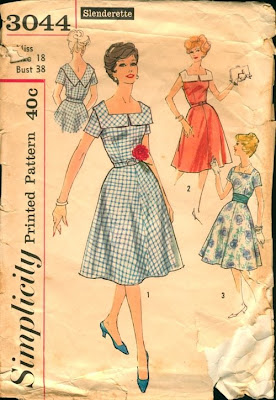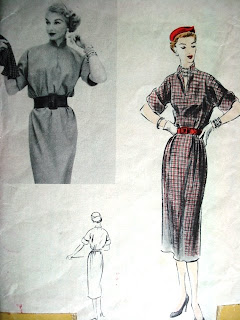 I wrote to Simplicity Patterns to try to get the inside scoop of the "slenderette" pattern line from the 50's and 60's. A very helpful employee responded!
I wrote to Simplicity Patterns to try to get the inside scoop of the "slenderette" pattern line from the 50's and 60's. A very helpful employee responded!Nicole, our friend from Simplicity, writes that the term slenderette "was only used as a design name for patterns and garments that would essentially make you look more slender." So there we have it! This explains why it was available in such a large range of sizes, not just "plus" sizes (whatever that means in the world of vintage patterns).
In Vogue's New Book for Better Sewing,there's an interesting parallel. In the section on "Selecting Your Patterns," they offer up this bit of advice for a "slenderette" effect:
If you wear a size 44 or 46, look in the separate section in the Vogue Pattern Counter Catalogue. There you will find a varied choice of patterns designed with subtle arrangements of vertical lines, panels or gores that help give an illusion of slimness.Interesting, eh?
And then there's the "Half Size Slenderette." To my query about these sizes, Nicole from Simplicity responded:
"From the 50’s to around the 70’s half sizes catered to a shorter fuller figured body type and were available not only in patterns but also ready to wear. So it wasn’t for petite or plus size it was its own category of clothing."Now to the giveaway! I have this Half Size Slenderette pattern (below) to give to a good home. It's a lovely shirtdress with a full or slim skirt option, as well as short or three-quarter sleeves. It's a half size 14-1/2, which means a 35" inch bust, 29" waist, and 39" hip. If you'd like to win this pattern, please leave a comment indicating that you'd like this pattern by the end of the day on Monday, August 3rd. I'll choose someone to bestow it upon. (If you don't want the pattern, you can still comment--and please do!)
 P.S. The pattern featured at the top of the post is a regular slenderette in a 38" bust, available from this wonderful seller!
P.S. The pattern featured at the top of the post is a regular slenderette in a 38" bust, available from this wonderful seller!

















































